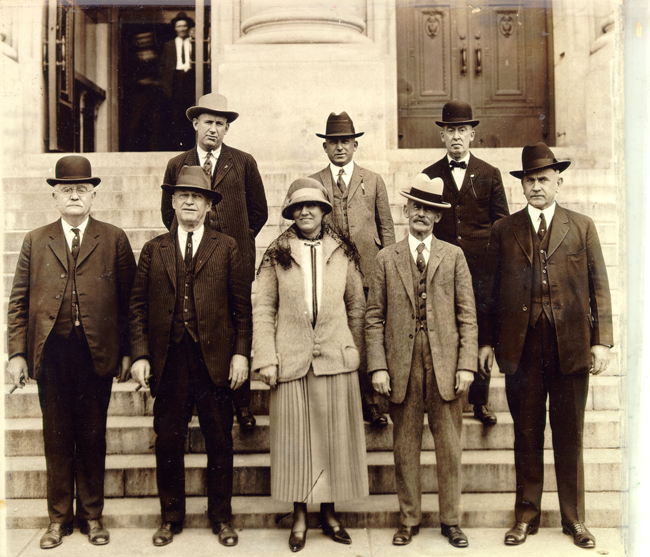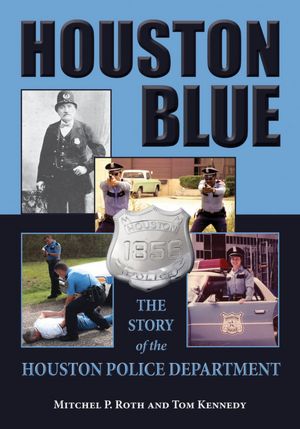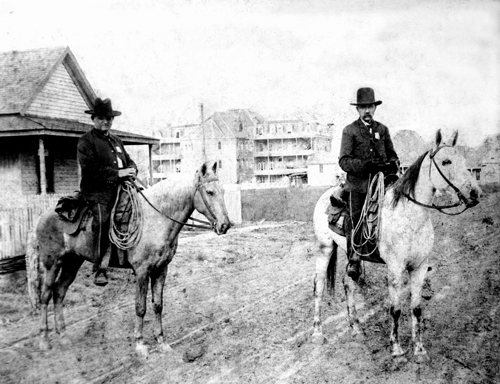New Book Shares Tales Of Houston 'Blues'
Aug. 23, 2012
SHSU Media Contact: Beth Kuhles
 |
| The first woman police officer in Houston, Eva Jane, stands among her colleagues. Her story is one of many criminal justice professor Mitchel Roth and former Houston Post columnis Tom Kennedy tell in their new book on the history of the Houston Police Department, Houston Blue. —Submitted photos |
Over the last 175 years, the Houston Police Department has had a colorful and controversial history, and Mitchel Roth and Tom Kennedy have documented it all: the good, the bad and the ugly.
 After four years and more than 100 interviews, Roth, a professor of criminal justice at Sam Houston State University, and Kennedy, a former Houston Post columnist, published Houston Blue, the first comprehensive history of the fourth largest police department in the United States. It includes tales from the city’s gritty beginnings as a trading post in the 1830s, its brushes with the famous and infamous, the controversies that have plagued the department, and the groundbreaking innovations developed along the way.
After four years and more than 100 interviews, Roth, a professor of criminal justice at Sam Houston State University, and Kennedy, a former Houston Post columnist, published Houston Blue, the first comprehensive history of the fourth largest police department in the United States. It includes tales from the city’s gritty beginnings as a trading post in the 1830s, its brushes with the famous and infamous, the controversies that have plagued the department, and the groundbreaking innovations developed along the way.
“It was a primitive place in the 1830s,” Roth said. “It took a while for it to become a modern police force. The same problems you have in Houston today, like traffic, you had 50 to 100 years ago. We covered it, blemishes and all.”
Back in the 1830s, Houston was not the urban center it is now; that was reserved for the coastal town on Galveston before the great Hurricane of 1900 that destroyed the city. Instead it was a town filled with rowdy young men and prostitution, overseen at first by constables and night watchmen.
“Before the police department, citizen groups would keep order,” Roth said.
The city served as a prime example of Southern policing, where the racial divide of the Civil War continued long after the war was over. Remnant of the old slave patrol, much of early policing was to keep African Americans under control. During the 1920s, the police force included many members of the Ku Klux Klan.
In sharp contrast to that backdrop, Roth found several black detectives who served on the police force in the late 1800s, although their work was heavily circumscribed and limited to the African American communities. In 1918, he also found what may be the first female police officer in the South, who watched over juveniles and young women in the town for signs of prostitution.
“In the Progressive Era, Eva Jane would watch over young girls who made goo-goo eyes over the WWI soldiers and shipped them off for VD (venereal disease) testing,” Roth said. “She would go to movie theaters and skating rinks and watch over everyone and write about it in a journal.”
 |
| One of the oldest known pictures of the Houston Police Department, from the 1880s. |
Houston also was known for several policing innovations. Houston was the first department in the South to use fingerprints for identification; polygraph exams and sodium pentothal for detecting the truth in interviews; and a number of traffic control innovations were implemented to control the morass of horses, cars, motorcycles and bicycles.
Under the leadership of Police Chief Lee P. Brown in the 1980s, the city led the nation in community policing, harkening back to the day when officers used to walk the beat before automobiles. Brown went on to lead police forces in Atlanta and New York and became the first African American mayor of Houston from 1998 to 2004.
The department has not been without controversy. Over the years, it has been plagued by cases of police brutality, shootings, problems with its crime lab, and errant police pursuits. In fact, one case, the Joe Campos Torres murder, where a Hispanic veteran was beaten and died after being thrown in the Buffalo Bayou, has ties to Sam Houston State University. After a change of venue was granted for the two officers involved, the case was transferred to the Criminal Justice Center courtroom for trial.
The Houston Police Department had its share of brushes with celebrities and politicians as well as famous killers, like serial murderer Dean “Candy Man” Corll, who killed 28 Houston boys and buried them near bodies of water in Texas, and Dr. John Hill, convicted of poisoning his socialite wife, which became the basis for the best-selling novel Blood and Money.
Magician Harry Houdini enlisted the help of the Houston Police Department for one of his famous tricks in front of City Hall, and former President Teddy Roosevelt and the Rough Riders stopped in town following their battles in the Spanish-American War.
But Roth’s favorite story was about the Hilton Siamese Twins. Daisy and Violet Hilton were pulled over for traffic violations during a tour stop in Houston, but police didn’t know which one should get the ticket.
Roth was asked by the Houston Police Officers Union to write the book, along with Kennedy, who served as the editor of the organization’s newsletter, “Badge & Gun.” As a longtime reporter, Kennedy had contacts among the city’s mayors and police chiefs.
Roth was given full access to the Houston Police museum archives and found many other records at the University of Houston and the University of Texas. Together, they pieced together the stories that molded the department into what it is today.
“This city is more diverse than most and the police department is changing with the times,” Roth said. “You are seeing the police department mirroring the community in terms of race and ethnicity. It’s a work in progress.”
Houston Blue, which will be published by the University of North Texas Press, will be available in November.
- END -
This page maintained by SHSU's Communications Office
Associate Director: Julia May
Manager: Jennifer Gauntt
Located in the 115 Administration Building
Telephone: 936.294.1836; Fax: 936.294.1834
Please send comments, corrections, news tips to Today@Sam.edu.

 SamWeb
SamWeb My Sam
My Sam E-mail
E-mail

